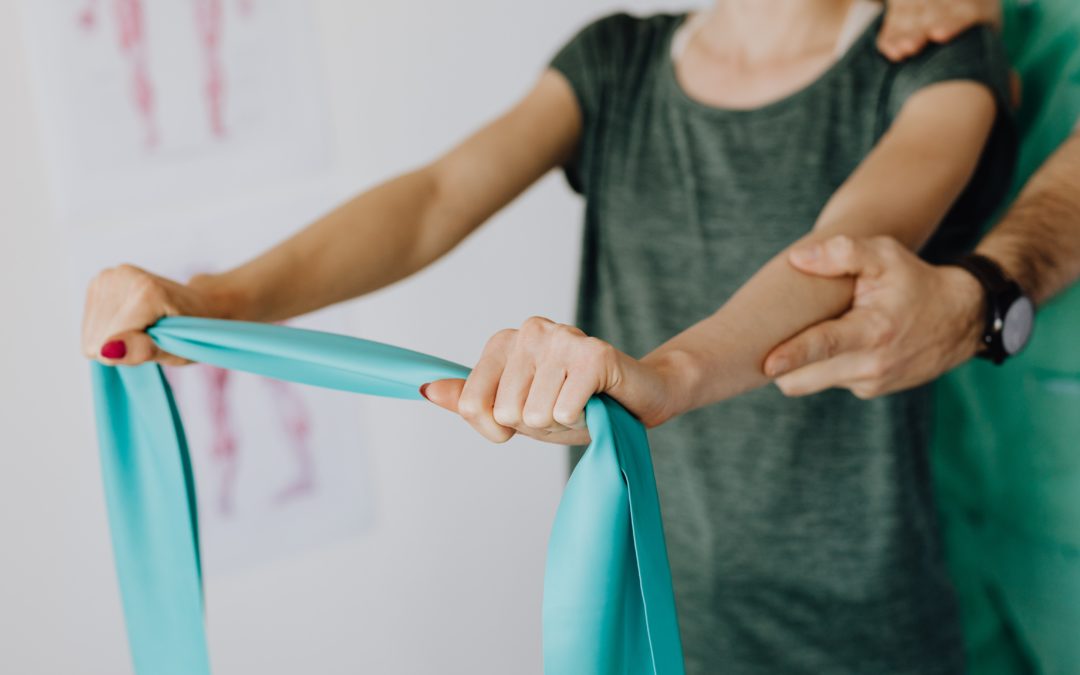Many individuals end up at their primary care office with shoulder pain when chiropractic may be a better option. They often don’t find a resolution to their pain and that is because they may have an often overlooked, altered shoulder blade position and motion pattern called “Scapular dyskinesis.” (1,2)
When the upper arm bone called the humerus and the shoulder blade called the scapula are moving in conjunction with each other the shoulder motion is considered normal. This is called normal scapulohumeral motion. This is when the head of the arm bone stays within the socket of the shoulder blade. This integrated motion between these two bones is the key to efficient function and joint stability. (3) A disruption in the movement of the shoulder blade will create increased stress on the shoulder capsule and rotator cuff. (4)
Causes of scapular dyskinesis
Muscular imbalance is the most common cause of scapular dyskinesis. Some muscles are weak and other muscles are tight leading to fatigue and altered activation. (5) One common pattern is tightness in the pectoralis minor or short-head of the biceps. Since they both attach to the coracoid process the tightness causes them to pull it down which puts the shoulder blade in a protracted position. (6) Another muscle imbalance is weakness or fatigue in the lower trapezius and serratus anterior. Both of these imbalances can lead to a slouched posture which contributes to this condition as well. (7)
Scapular dyskinesis is usually the result of AC separation, A/C instability, A/C arthrosis, labral injury, glenohumeral internal derangement, glenohumeral instability, biceps tendinitis, and prior clavicle or scapula fracture. (8)
If the nerves that innervate the muscles that move the shoulder blade have been compromised then the cause could be cervical radiculopathy or peripheral neuropathy. (9)
Common symptoms of scapular dyskinesis
If you don’t already have a shoulder condition scapular dyskinesis can lead to one. The poor movement of the shoulder blade diminishes subacromial space and leads to decreased rotator cuff strength, impingement symptoms, and rotator cuff damage. (10) This can lead to loss of dynamic stability from damage to the anterior glenohumeral ligaments. (11) Most people have some form of shoulder blade asymmetry. (12) When this asymmetry leads to pain in the front, back, or top of the shoulder then this can be a problem. Sometimes the pain will move down the arm or down the back. The consequences of altered shoulder blade mechanics can cause other more difficult to treat conditions.
How to evaluate scapular dyskinesis
Once altered scapular mechanics have been identified the goal is to determine why. (13) The acronym “SICK” has been created as a guide to figure out the components of scapular dyskinesis. These are:
- Scapular malposition- winging of the shoulder blade
- Inferior angle prominence- the bottom tip of the shoulder blade protrudes
- Coracoid tenderness/malposition- tenderness at the front of the shoulder
- dysKinesis. – altered movement of the shoulder blade when raising the arm overhead. (14)
These components are assessed while standing still and while moving the arm. Functional movement tests such as the Scapulohumeral rhythm test and Scapular dyskinesis test can be used to gather more information. (15) The Scapular dyskinesis test involves moving the arm up in front of you and out to the side with small weights in the hands to see if there is winging or early, excessive, or dis-coordinated motion.
An assessment of posterior shoulder tightness can also be useful. Internal rotation of the arm can lead to scapular protraction and dyskinesis. To assess posterior capsule tightness bring the arm out to the side in line with the shoulder and then go into internal rotation to see which spinal level can be felt. Trigger points are possible in the pectoral, biceps, upper trapezius, and rotator cuff muscles.
Upper cervical chiropractic for scapular dyskinesis
Chiropractic and massage will produce significant improvements in pain and function. (16) This begins by restoring flexibility of tight muscles such as the pec minor, biceps, and upper trapezius. (17) Then strengthening exercises can be used for the serratus anterior, lower trapezius, and middle trapezius. (18)
Exercises to help heal scapular dyskinesis
Conclusion
If scapular dyskinesia is a part of your life and you are looking for an answer then I can help. I can help figure out what the cause of the scapular dyskinesia is. Use chiropractic adjustments and massage to get you out of pain and teach you the exercises you will need in order to build a resilient shoulder that is immune to pain. If you are ready to try this approach schedule with me today. Still looking for more information? Check out my eBook on Chronic Neck Pain.
References
1. Van der Windt DA, Koes BW, de Jong BA, Bouter LM. Shoulder disorders in general practice: incidence, patient characteristics, and management. Ann Rheum Dis, 1995;54(12):959-964.
2. Kibler WB, McMullen J. Scapular dyskinesis and its relation to shoulder pain. J Am Acad Orthop Surg,2003;11:142-151.
3. Warner J.J.P, Micheli L.J, Arslanian L.E, Kennedy J, Kennedy R. Scapulothoracic motion in normal shoulders and shoulders with glenohumeral instability and impingement syndrome. Clin Orthop Rel Res. 1992;285:191–199.
4. Oyama S, Myers JB, Wassinger CA, Daniel Ricci R, Lephart SM. Asymmetric resting scapular posture in healthy overhead athletes. J Athl Train. Oct-Dec 2008;43(6):565-570.
5. Kibler WB, McMullen J. Scapular dyskinesis and its relation to shoulder pain. J Amer Acad of Orthop Surgeons 2003;11(2):142-151.
6. Cools AM, Dewitte V, Lanszweert F, et al. Rehabilitation of scapular muscle balance. Am J Sports Med 2007;35:1744–51.
7. Borstad JD, Ludewig PM. The effect of long versus short pectoralis minor resting length on scapular kinematics in healthy individuals. J Orthop Sports Phys Ther 2005;35:227–38.
8. Sahrmann S. Diagnosis and treatment of movement impairment syndromes. St Louis: Mosby, 2001.
9. Kibler WB, Ludewig PM, McClure PW, et al. Scapula summit 2009. J Orthop Sports Phys Ther 2009;39:A1–13.
10. McQuade KJ, Dawson JD, Smidt GL. Scapulothoracic muscle fatique associated with alterations in scapulohumeral rhythm kinematics during maximum resistive shoulder elevation. Journal of Orthopaedic and Sports Physical Therapy. 1998;28(2):74-80.
11. Kebaetse M, McClure P, Pratt NA. Thoracic position effect on shoulder range of motion, strength, and three-dimensional scapular kinematics. Arch Phys Med Rehabil 1999;80:945–50.
12. Finley MA, Lee RY. Effect of sitting posture on 3-dimensional scapular kinematics measured by skin-mounted electromagnetic tracking sensors. Arch Phys Med Rehabil 2003;84:563–8.
13. Gumina S, Di Giorgio G, Postacchini F, Postacchini R. Subacromial space in adult patients with thoracic hyperkyphosis and in healthy volunteers. Chir Organi Mov. Feb 2008;91(2):93-96.
14. Kibler WB, Sciascia AD. Current concepts: scapular dyskinesis. Br J Sports Med 2010;44:300–5.
15. Kuhn J, Plancher K, Hawkins R. Scapular winging. J Am Acad Orthop Surg 1995;3:319–25.
16. Shailen Woods Comprehensive Approach to the Management of Scapular Dyskinesia in the Overhead Throwing Athlete. UPMCPhysicianResources.com/Rehab
17. Seitz AL, McClure P, Lynch SS, et al. Effects of scapular dyskinesis and scapular assistance test on subacromi space during static arm elevation. J Shoulder Elbow Surg 2012;21:631–40.
18. Atalar H, Yilmaz C, Polat O, et al. Restricted scapular mobility during arm abduction: implications for impingement syndrome. Acta Orthopaedica Belgica 2009;75:19–24.
-

Heal AC Joint Injuries Naturally
$60.00 -

Heal Bicep Tendinopathy Naturally
$60.00 -

Heal Plantar Fasciitis Naturally
$60.00 -
Sale!

RaquetFit Screen for Tennis Athletes
Original price was: $30.00.$0.00Current price is: $0.00. -
Sale!

Selective Functional Movement Assessment
Original price was: $30.00.$0.00Current price is: $0.00. -

The Master Student Book 1
$7.99 -

The Master Student Book 2
$7.99 -

The Rotator Cuff Healing Blueprint
$60.00

